The premise is simple: read one comic every day for the entire year. It seems like a simple task but there is no way that I read 365 comics last year, even if you count the individual issues in collections. So, this year, I am committing myself to this reading challenge, in the hope that I can broaden my reading habits and fully engage with my favorite hobby again.
“We were children in Eden. Too young to know how every paradise story ends.” – from Planet of the Apes #10 by Daryl Gregory and Carlos Magno
I think that the phrase “this week is going to be a little bit different” is becoming something of a mantra and “different” is quickly turning into the “norm.” However, I’m going to lump all of this week’s comics into one big pile of Planet of the Apes goodness. I started the week reading the first issue of Daryl Gregory’s 2011 run on BOOM! Studios’ Planet of the Apes thinking I’d read the first arc and use that as Comic Number 161. By the end of Monday I had read 15 issues, leaving only 1 of the monthly issues left and the 4 specials.
MFR ON YOUTUBE (latest video)
Help us reach 5K Subs!
If you were to check my tiny bio on this website you’ll see that there are two franchises that I clearly love: Doctor Who and Planet of the Apes. I rarely talk about Doctor Who because I’m mainly a fan of the television show and haven’t found the same love for the extended universe of books, comics, etc. With Planet of the Apes, it’s completely different. I love the comics and the books (the ones that I have), I love the films and the television show (both live action and cartoon). Hanging with Doctor Z is one of my favorite YouTube channels.
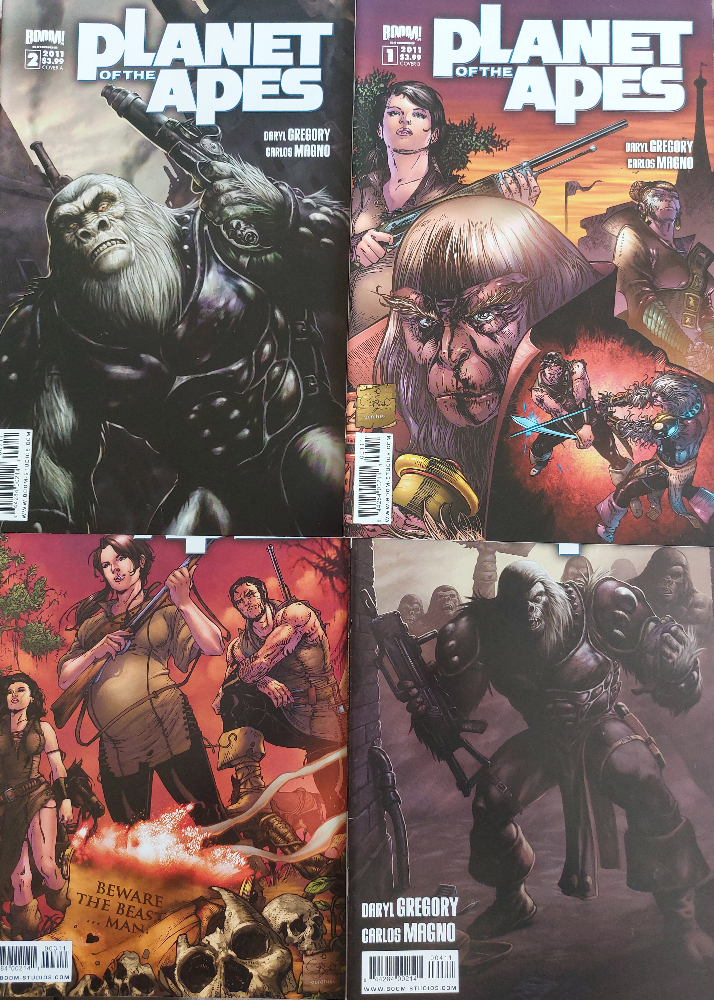
Credit: BOOM! Studies
There is something endearing about the extended franchise; 99% of the people involved with the tie-ins are clearly massive fans of the original movies. The themes and ideas introduced in the original movie, which to a large extent are taken from Pierre Boulle’s novel, strike a chord with storytellers and fans the world over. In the book Comics on the Planet of the Apes, Joseph F. Berenato writes “Planet of the Apes has long been successful not just because it’s a planet full of talking apes, but also because of the social commentary that has been weaved throughout the franchise.” Every piece of media that pops up relating to Planet of the Apes has, at its heart, something to say about the society in which it has been produced. And this is especially true of the comics. Each era of the comic draws inspiration from the cultural world around it and reflects that inspiration within the narratives and characters. To look at the first Marvel Apes comics is to see a world of mind bending experimentation and the dangers of segregation and bigotry. The violence and high tech gadgetry of the 1990’s comic industry is represented in the Malibu Apes comics which are presented in a less polished but creatively freer, indie style of product. And the BOOM! Studios comics explore relationships and the nature of good and evil, with a heavy focus on politics and conspiracy.
Daryl Gregory begins his run with The Long War, a story set in the shared Ape and Human city of Mak. It is set in 2680 A.D. — over a thousand years before Charlton Heston will arrive on the planet with his 1960s cynicism, and 600 years after Roddy McDowall threw a gorilla out of a tree. It starts strong and violent with the assassination of the Lawgiver by a ninja clad human wielding an assault weapon. This act is the first stone of an avalanche that will ultimately destroy the city and tear the central characters apart.
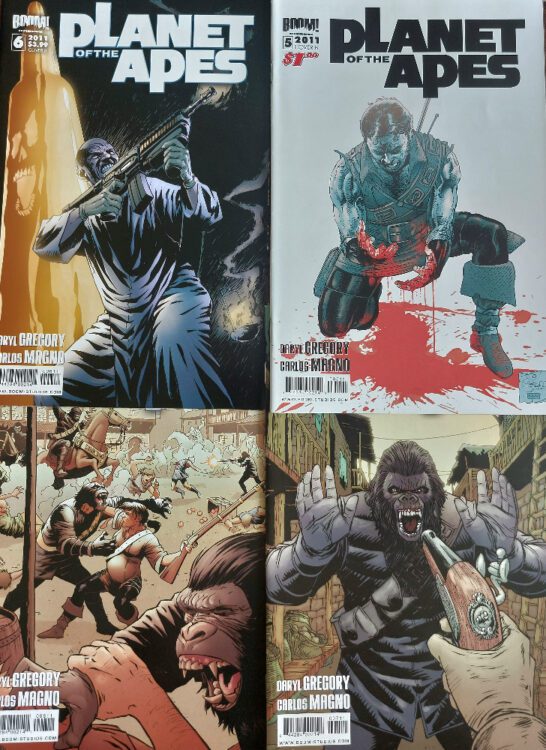
Credit: BOOM! Studies
Gregory uses two adoptive sisters as the central characters, one human and the other ape. This allows him to continually show both sides of the story, meaning it is never a simple story of Ape Evil, Human Good, or vice versa. The reader has sympathies for both sides and more often than not, you find yourself wanting them to reconcile their differences instead of massacring each other.
The artwork on the initial 16 issues is by Carlos Magno, who captures the design of the original movies, but makes it very much his own. The characters are full of life, and the individualism is impressive. Every human and every ape is different in look, in stance, and in action. Magno populates his complex world with equally complex characters, and it is a pure joy to read. Each page is exquisitely detailed and no part of the city is left unexplored.
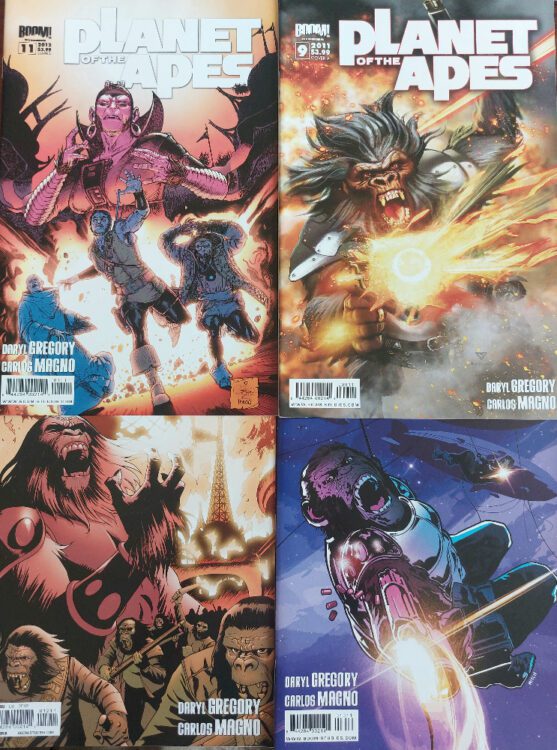
Credit: BOOM! Studies
Between them, Gregory and Magno create a world that is believable and fits perfectly into the Apes franchise. It is difficult to pick out a favorite part of the narrative or a single character from the 16 issue run because it’s all so damn good. The leads Alaya (ape) and Sully (human) are the most explored characters, but the albino gorilla general Nix is a superb character with a long development arc. He’s unforgettable like the human Wyn, “the name and the game.” Wyn is adorable at first, a sneaky thief, but he bears witness to some atrocities that affect him mentally and then physically. He is literally scared by the war that transpires.
After the four-arc main series, Gregory finishes his story off in a collection of specials, each drawn by a different artist. I personally don’t think that the art reaches the same heady heights as Magno, but the conclusion is more than satisfactory and continues to match the themes and story beats of the Apes franchise. Destruction and hope are the uncomfortable bedfellows of 21st century Ape stories.
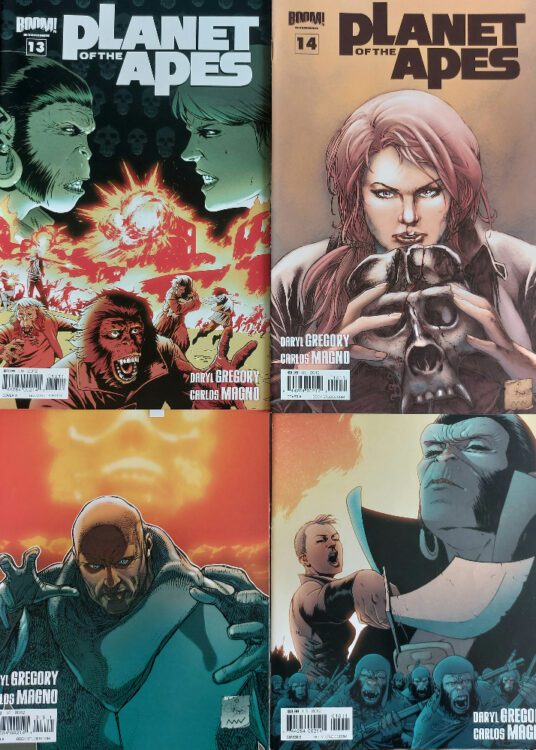
Credit: BOOM! Studies
While Gregory and Magno are weaving their tale on the Planet of the Apes, BOOM! Studios started releasing another series in the franchise. Starting as a four-part miniseries, Corinna Bechko and Gabriel Hardman’s Betrayal on the Planet of the Apes is actually the start of another 20-issue story that starts 20 years before the setting of the first movie and rolls right up to the bitter end. Again, the characters are what makes the series although, due to the time period this is set, it is the conflict between the different ape factions that provides the drama. Humans play a part, but it is the apes who wield all the narrative power.
Bechko creates some very interesting and complex characters who don’t fall into the usual stereotypes of the ape casting. The central Gorilla, Aleron, is more than a military leader and turns out to be a humanist in a society tearing itself apart with hatred and racism. However, one of the strongest elements of this run is the way that Bechko incorporates characters and aspects of the original movie. Elements of the world glimpsed in the movie, or suspiciously not seen in the case of the Moon, are explored and the characteristics of the central cast are developed. By the end, characters like Zaius are perfectly rounded with histories that explain their behavior in the movie.
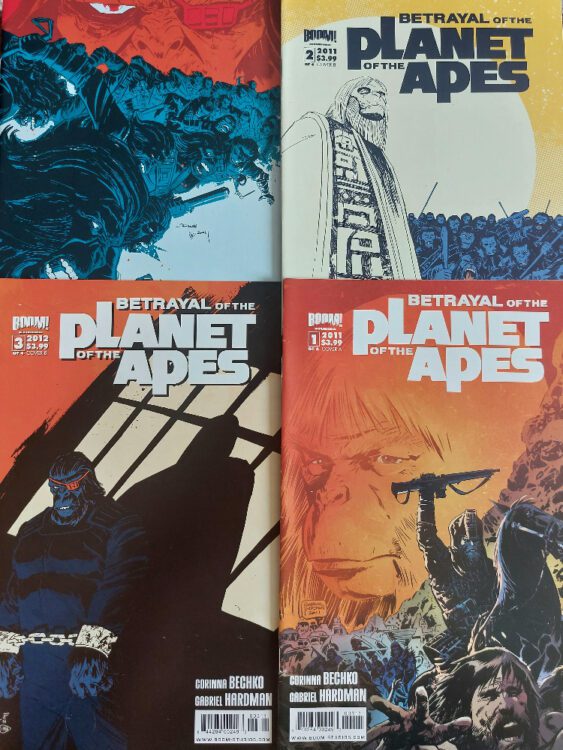
Credit: BOOM! Studies
It must be said that Hardman’s artwork in the first two story arcs is outstanding. He has a strong, distinctive style that highlights characters in a panel while creating fascinating backgrounds that are more emotional than descriptive. The visuals are impactful, which owes a lot to Jordie Bellaire’s color work. Bellaire is one of the best in the business and it shows in these comics. The coloring stresses narrative points, but it also matches with the characters on the page. In later issues, as the conversation jumps from a group of chimpanzees to a group of orangutans, the color washes on the page switches from the green of the chimps’ tunics to the orange of the orangutans. Subtle plays on the page make massive differences to the reading experience. It helps to clarify characters while setting the mood and tone for the narrative.
This attention to detail and high quality work illustrates the love that creators have for this franchise. A number of movie/tv tie-ins are by the book creations, lacking in conviction and mere reflections of their moving image counterparts. In many ways, the Ape comic series are equal, if not superior, to the original movies because the creators treat the franchise with respect and admiration. It’s like highly polished fan fiction.
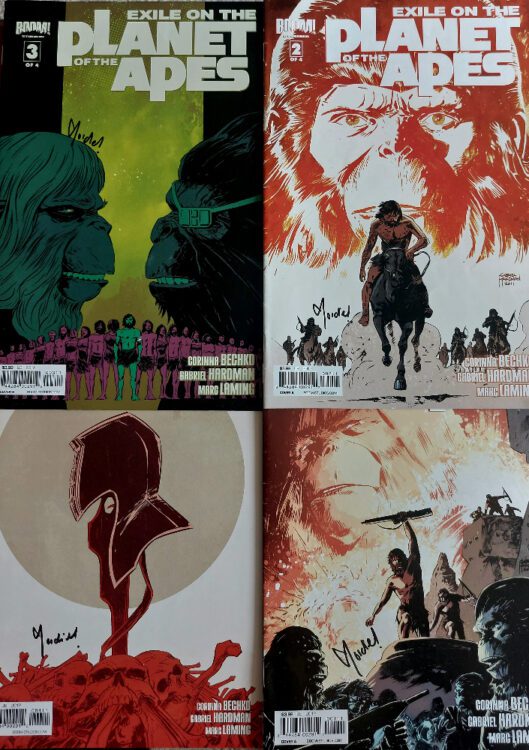
Credit: BOOM! Studies
Betrayal (4 issues), Exile (4 issues), and finally Cataclysm (12 issues) is another superb run of comics that easily appeals to both fans and non fans of the series. Arguably there is more for fans of the franchise in this run than in Daryl Gregory’s run but there is nothing that would alienate readers. I love both series equally, and enjoy them each time I re-read them.
All in all, that’s 40 comics I’ve read this week. I’ll let you pick and choose which ones should be placed in the slots for this week’s comics numbered 161 to 167, as I have an urge to go and watch the Planet of the Apes T.V. series.
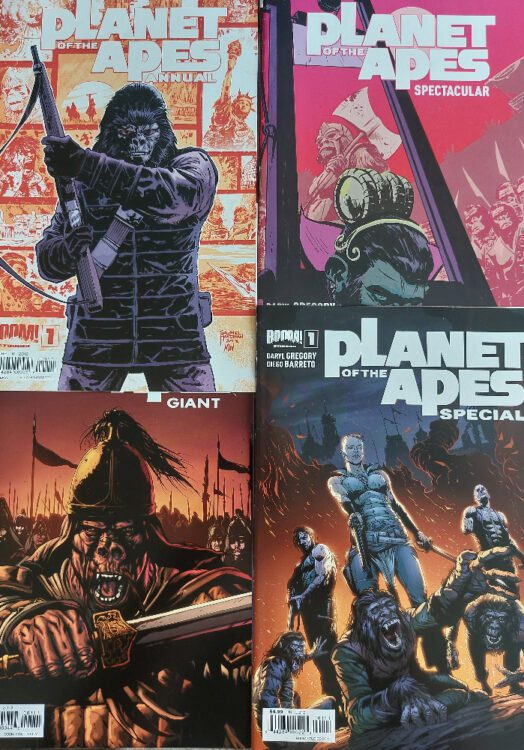
Come back again next week for PROJECT 365, Week 25!

